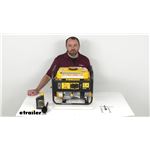Firman 1,500-Watt Portable RV Generator - 1,200 Running Watts - Gas - Manual Start
- All Info
- Reviews (4)
- Q & A (0)
- Videos (1)
- Photos
Firman Generators - FIR93VR
- No Inverter
- Gas
- Hand Carry
- Firman
- 1200 Running Watts
- 1500 Starting Watts
- 120 Volt Output
- Recoil Start
- CARB Approved
This gas generator is small but mighty, and it's easy to move around since it weighs only 55 lbs. A good choice for powering small appliances for RVing, tailgating, or emergencies. CO Alert turns engine off when hazardous gas buildup is detected.
Features:
- 1,500-Watt gas generator provides a portable power source
- Engine starts reliably using the manual recoil handle
- Firman 4-stroke engine uses standard unleaded gas or propane - no need to mix gas and oil
- Built-in safety features include CO Alert sensor, warning lights, voltage regulator, and spark arrestor
- Strong, tubular steel frame
- Clean-running engine meets CARB, cETL, and EPA standards
Specs:
- Outlets: (2) 120V 20-amp 5-20R
- Starting (surge) power output: 1,500 watts
- Running (rated) power output: 1,200 watts
- Continuous run time at 1/2 load: 10 hours
- Noise level (normal conversation is 60 dB):
- Measured at 25' away at 1/2 load in standard mode: 62 dB
- Engine type: Single Cylinder, 4-Stroke OHV Air Cooled, 80cc
- Fuel type: gasoline
- Gas tank capacity: 1.7 gal
- Oil type: SAE 10W-30
- Capacity: 0.4 qt
- Power line frequency: 60 Hz
- Dry weight: 55 lbs
- Dimensions: 17-1/2" long x 14-1/4" wide x 15" tall
- Warranty: 3 years
Includes:
- Engine oil
- Oil funnel
- Spark plug wrench
- 2 Double open wrenches (10 mm and 12 mm)
Notes:
- Gas generators produce carbon monoxide, which is poisonous. For your safety, always be sure to operate this gas-powered generator outdoors.
- Because this generator does not have a built-in inverter to control the electrical current, the voltage can fluctuate. Therefore, do not plug sensitive electronic devices such as a computer or television into the generator.
Certifications
Meets the following important certification standards:
- US Environmental Protection Agency (EPA)
- California Air Resources Board (CARB)
- cETL - Compliant with North American Safety Standards
Choosing a Generator
When choosing a generator, you need to match the generator's starting and running output with the electrical demands of the equipment you want to operate.
Power Demands
Starting (surge) wattage is the power a device requires at startup. Running (rated) wattage is the power needed to keep the device running. A large appliance with an electric motor such as a furnace, refrigerator, air conditioner, or washing machine may require 2 to 3 times more starting wattage than running wattage.
It is always best to start your generator with no load connected, then add each device one at a time. Additionally, a good practice to consider is connecting your devices in order from highest starting watts to lowest starting watts. As you connect and start devices, your available wattage decreases. This order of operation allows you to start devices with the highest power demands when there is more power available.
Will This Generator Run My RV Air Conditioner?
At etrailer, we perform numerous tests on generators that put them through real-world experience. An extensive part of this testing includes starting and running RV air conditioners. The following table will help you decide if the P01204 generator has enough power to handle this critical function in your RV.
| Air Conditioner | Will it start and run? |
|---|---|
| Single 13,500 Btu | Yes |
| Single 15,000 Btu | Yes |
| Dual 15,000 Btu | Yes |
Running Watts and Starting Watts of Common Appliances
| Appliance | Running Watts | Starting Watts |
|---|---|---|
| Air compressor (1/2 hp) | 1,000 | 2,000 |
| Air conditioner (15,000 Btu ) | 1,600 | * |
| Air conditioner (13,500 Btu ) | 1,300 | * |
| Air conditioner (10,000 Btu ) | 1,000 | * |
| Blender | 400 | 850 |
| Cell phone charger | 11 | 0 |
| Clock radio | 4 | 0 |
| Coffee maker (high setting) | 1,066 | 0 |
| Crock pot (low setting) | 126 | 0 |
| Crock pot (high setting) | 374 | 0 |
| Desktop computer | 150 - 350 | 0 |
| DVD player | 14 | 0 |
| Electric drill (3/8" / 4 amps) | 450 | 600 |
| Electric space heater (high setting) | 1,450 | 0 |
| Floor fan | 100 | 0 |
| Hair dryer (low setting) | 160 | 0 |
| Hair dryer (high setting) | 1,300 | 0 |
| LCD television (32") | 68 | 0 |
| Microwave | 1,000 | 0 |
| Refrigerator | 800 | 1,600 |
| Washing machine | 1,150 | 2,250 |
| Work light (quartz halogen) | 1,000 | 0 |
* The starting wattage on air conditioners can vary greatly depending on several factors, including the assistance of built-in capacitors and cold starts. Because of this, we can't list a standard starting wattage as every application can be different.
Determining Your Power Needs
The following section provides calculations for wattage estimates. This will give you an overall picture of your potential power usage and help you decide on the generator that is right for you.
Industry Standard Calculation
The Industry Standard Calculation is a quick and easy way to determine your required wattage. It may provide some padding in your wattage requirements, which could give you more power than you actually need, but you shouldn't have to worry about not having enough power. The following steps will help you quickly calculate the correct size generator to meet your application.
As stated earlier, you should always start your generator without any load, and then connect each device one at a time. The following calculation requires this approach to work. However, using this calculation removes the worry of connecting devices in a certain order.
1. Determine the starting watts and running watts for the devices that you want to plug into the generator.
a. Find the starting (surge) watts and running (rated) watts for each device that you want to plug into the generator. Look for a sticker or plate on each device or check your owner's manuals.
b. If your device or manual only shows amps and volts, watts can also be determined through a simple formula. (Amps x Volts = Watts)
c. List all of your starting watts and running watts as seen in Table 1 below.
Table 1
| Example Devices | Starting Watts | Running Watts |
|---|---|---|
| Air compressor | 2,000 | 1,000 |
| Refrigerator | 1,600 | 800 |
| Microwave | 0 | 1,000 |
| Blender | 850 | 400 |
2. To find the total starting watts required , add the starting watts for the device with the highest value to the running watts of all the other devices from Table 1 .
2,000 + 800 + 1,000 + 400 = 4,200 total starting watts
3. To find the total running watts , add all of the running watts together from Table 1 .
1,000 + 800 + 1,000 + 400 = 3,200 total running watts
To run all of these devices simultaneously, you would require a generator with at least 4,200 starting watts and 3,200 running watts.
Advanced, Precise Calculation
While the method for calculating your power needs outlined above will work, it isn't the most precise. If you aren't afraid of doing a little more math, you can use the Advanced, Precise Calculation to get a more accurate idea of how much power you will need and potentially save yourself some money. Because the calculation above pads in enough power to ensure you can start your devices in any order, it may point you to a bigger and more expensive generator than you need. However, by following the more regimented, order-of-operations calculation below, you'll get a much more precise idea of how much power you need, which could in turn point you to a smaller and less expensive generator.
Again, you should always start your generator without any load, and then connect each device one at a time. The following calculation also requires that you start your devices in order from highest starting watts to lowest starting watts. When you connect devices in this order, you can start high demand devices when there is more power available.
1. Determine the starting watts and running watts for each device that you want to plug into the generator.
a. Find the starting (surge) watts and running (rated) watts for each device that you want to plug into the generator. Look for a sticker or plate on each device or check your owner's manuals.
b. If your device or manual only shows amps and volts, watts can also be determined through a simple formula. (Amps x Volts = Watts)
c. List out these devices from highest starting watts to lowest starting watts as seen in Table 2 below.
Table 2
| Example Devices | Starting Watts | Running Watts |
|---|---|---|
| Air compressor | 2,000 | 1,000 |
| Refrigerator | 1,600 | 800 |
| Microwave | 0 | 1,000 |
| Blender | 850 | 400 |
2. To find the total running watts , add all of the running watts together from Table 2 .
1,000 + 800 + 1,000 + 400 = 3,200 total running watts
3. In Table 3 , shown below, the values from Table 2 are used to calculate the highest total starting watts required as devices are connected and running. This number represents the highest power requirement you will encounter as you connect all of your devices to the generator. To find this, add the starting watts of each new device you connect to the combined running watts of all connected devices . The highest of these numbers will be the total starting watts required . And again, remember to always connect devices in order from highest starting watts to lowest starting watts.
Table 3
| Device | Starting Watts | Running Watts of All Connected Devices | Total Starting Watts Required |
|---|---|---|---|
| 1. Air compressor | 2,000 + | 0 (nothing connected) | = 2,000 |
| 2. Refrigerator | 1,600 + | 1,000 (air compressor) | = 2,600 |
| 3. Microwave | 1,000* + | 1,800 (air compressor + refrigerator) | = 2,800 |
| 4. Blender | 850 + | 2,800 (air compressor + refrigerator + microwave) | = 3,650 |
* Even though the microwave does not have starting watts listed, you have to account for the power needed to actually run it.
850 + 2,800 = 3,650 highest total starting watts required
In order to run all of these devices simultaneously, you would require a generator with at least 3,650 starting watts and 3,200 running watts.
P01204 Gas Portable Generator 1500/1200W Recoil CO Alert 50 ST CAN
California residents: click here


Videos are provided as a guide only. Refer to manufacturer installation instructions and specs for complete information.
Video Transcript for Review of Firman Generators - 1500 Watt Portable Gas Generator - FIR93VR
Hi, everybody. Andy here with etrailer.com. Let's take a look at this Firman 1500-watt portable gas generator. Now, this gas powered generator weighs about 54 pounds. So this is gonna be a great option to consider for powering your small appliances, whether you're out RVing or tailgating. This is gonna be great for emergency situations as well.
This is gonna provide 120-volt power to run your equipment. Now, when choosing a generator, you do need to match the generator starting and running output with the electrical demands of the equipment that you want to power and operate. So I wanted to point out that if you haven't seen it already, on this product page, we have provided a really good writeup for you to help you to determine the type of generator that's going to work best for your particular application. So if you haven't already, take a look at that information that we've provided for you. We wanna make sure that you get just the perfect generator for your particular application.
Taking a closer look at this generator, this generator is equipped with a starting power output of 1500 watts and then a running power output of 1200 watts. This engine is going to start reliably using the manual recoil handle. And this does feature, as you can see here, Firman's 80cc overhead valve air cooled engine. This has a continuous runtime of 10 hours at a 50% load. And this is a clean running engine that's going to meet CARB, cETL, and EPA standards.
And I'd like to give you an overhead look here at the tank. Let me line that up there for you. This is a 1.7-gallon steel tank. So this is gonna be very easy to fill up. We do have a filter there where you fill the fuel up.
But very easy to open and close. We also have our fuel gauge, so you always know how much fuel you have left in the tank. Now, in regards to noise level, the noise of a normal conversation is about 60 decibels. To know the noise level of this generator, measured at about 25 feet away when this is running at a 75% load, the noise level on this is gonna be about 74 decibels. Hopefully, that kinda gives you an idea of what type of noise to expect from this generator. I wanna go over the control panel here up front and show you the features here. So we have our engine start switch. So you'll just turn that switch on and then pull the recoil cord to start the engine. And then we have our CO Alert, carbon monoxide shut down indicator light. And then we have our 120-volt, 20-amp outlets there to plug in your equipment. Notice, we have a really nice cover here as well to cover up that outlet when it's not in use. Circuit breaker, and then ground terminal. And then we have a spark arrester here. And then I just wanted to point out here, we have our fuel shutoff or choke. And this is a very strong steel tubular frame that we have here around this generator. And thus, this does include some other things as well which is pretty handy. You're gonna get a bottle of oil, a funnel, and then a spark plug wrench, and then two other open wrenches here, 10 millimeter and 12 millimeter. And we do have our oil fill here as well. So it's gonna be very easy to maintain this and very easy to run as well. Let me give you some measurements just so you have a good idea of the size. So looking at the overall length, we are sitting right at about 17 1/2 inches long. Looking at the width, lining that up, we're sitting at about 14 1/4 inches wide. And then the height, about 15 inches tall. Now, just a couple of final notes. Gas generators do produce carbon monoxide, as I'm sure you know, which, of course, is poisonous. So for your safety, you always wanna be sure to operate this gas powered generator outdoors. And because this generator does not have a built-in inverter to control the electrical current, the voltage can fluctuate. So you wanna be sure that you don't plug in your sensitive electronic devices, such as tablets or computers, or even smartphones, things like that, because the voltage can fluctuate since this does not have an inverter installed. Well, I think that's gonna wrap up our look today. I do hope that our time together has been helpful for you. Again, my name is Andy. Thank you for joining me.
Ratings & Reviews
5.0
3 reviews
both generators are excellent
Info for this part was:





At etrailer we provide the best information available about the products we sell. We take the quality of our information seriously so that you can get the right part the first time. Let us know if anything is missing or if you have any questions.










































Thank you! Your comment has been submitted successfully. You should be able to view your question/comment here within a few days.
Error submitting comment. Please try again momentarily.